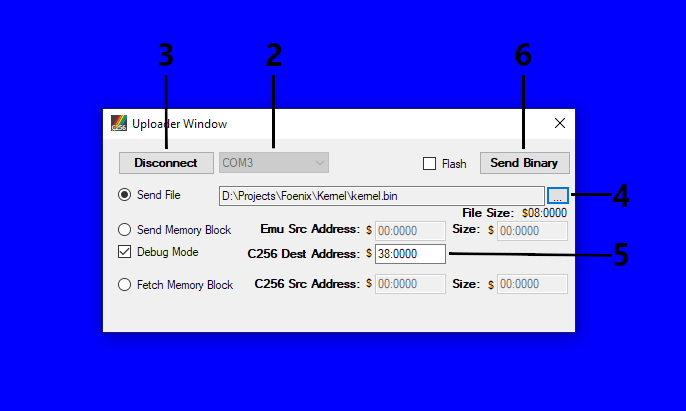Getting Started Guide
Jump to navigation
Jump to search
Contents
Getting Started Guide
Installing Drivers
Data and programs can be sent to the C256 Foenix over the USB debug port (the USB port on the right side of the board, next to the expansion connector). The debug interface is a USB serial port which requires a driver to be installed on the host system. The drivers for the serial USB device (XR21V1411) can be found at: https://www.maxlinear.com/support/design-tools/software-drivers.
Helpful Tools
- Foenix IDE
- The Foenix IDE is a full-featured emulator and board manager tool written in C#. The bulk of the Foenix IDE is an emulator of the C256 Foenix which emulates several key systems of the C256 and allows for breakpoints in the code, examination of memory, and so on. The IDE can also connect to the physical C256 through the USB debug interface. It can use the interface to upload data from a BIN file, an Intel HEX file, or the IDE emulator's memory into the C256, download memory from the C256 into the emulator's memory to be examined through the IDE, or to reprogram the C256's flash memory. Although a GUI application by default, the IDE can be used as a command line tool. The IDE also includes a character set / font editor tool, allowing you to design your own characters to use in your C256 programs. The source code for the IDE as well as the latest binary can be found at: https://github.com/Trinity-11/FoenixIDE.
- C256Mgr
- C256Mgr is a set of Python scripts allowing access to the C256's USB debug interface. The scripts allow you to use the command line to upload BIN and HEX files to the C256, reprogram the flash memory, or examine memory on the C256. If your code includes a 64Tass compatible LBL file, the C256Mgr scripts can use that LBL file to allow you to examine memory based on the labels in your code. C256Mgr was originally intended to provide a cross-platform option for those who cannot run .Net applications. The C256Mgr can be found at: https://github.com/pweingar/C256Mgr.
- 64Tass
- Although any assembler that can produce 65816 code can be used to write code for the C256, the kernel, BASIC interpreter, and much of the sample code are written using 64Tass, which can be found at: https://sourceforge.net/projects/tass64/.
Uploading with the Foenix IDE
To upload a BIN or HEX file with the Foenix IDE's user interface:
- Select the Tools > Uploader menu option. An "Uploader Window" will open.
- Select the COM port associated with the C256 debug interface in the drop down selector.
- Click the "Connect" button to establish a connection to the C256.
- Click the button labeled with ellipsis (...) to select the file to upload. By default, the uploader will show BIN files, but you can choose to search for HEX files instead.
- If you are uploading a BIN file, enter the starting destination address in the field "C256 Dest Address". This step is not needed with HEX files, since they have the destination addresses for their data included.
- Click the "Send Binary" button to start the upload process.
